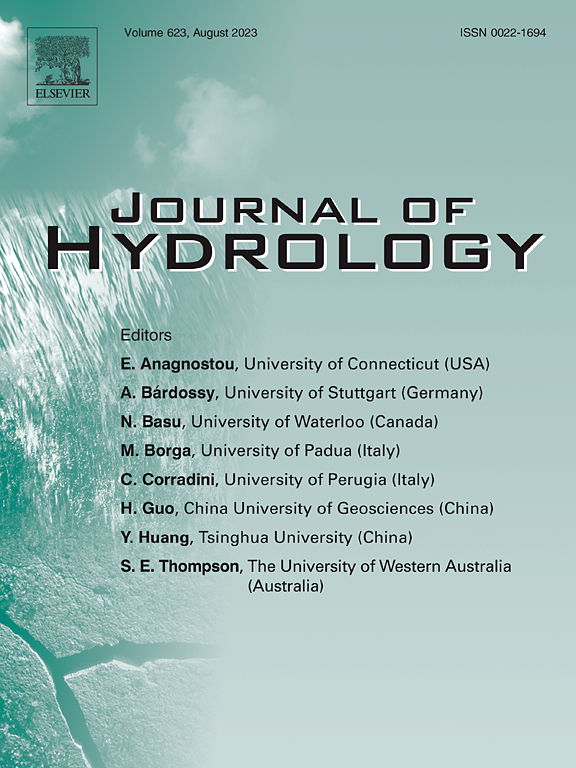Groundwater anomaly variation and its response to environment change in an inland river basin, China
IF 6.3
1区 地球科学
Q1 ENGINEERING, CIVIL
引用次数: 0
Abstract
Inland river basins have plunged into water shortage with growing social development, as an important component of water resources, groundwater provides a large water supply for inland river basins. However, current understanding of groundwater dynamics and corresponding response to environment remains deficient owing to insufficient data, which needs to be further explored. To address this, we assessed groundwater storage anomaly (GWSA) through GRACE-based records over a typical inland river basin, Shiyang river basin, and analysis relevant response characteristics to environment. Annual GWSA peaked in 2004 and followed by sharply decline until 2010. Although a minor rebound occurred afterward, but overall trend of GWSA remained downward. Spatially, approximately 85 % of basin experienced a significant decline over −0.65 mm/year. In intra-annual scale, monthly GWSA show a double-peaked pattern in mountainous area while a single-peaked pattern in rest area. From 2002 to 2020, precipitation, temperature, evapotranspiration, vegetation and soil moisture show increasing trends. The largest landuse area change are cropland and unused land, cropland area was mainly converted from unused land and low-coverage grassland. Meanwhile, water and city land have increased significantly, by 21.41 % and 50.59 %, respectively, with the major transformation from unused land and cropland in oasis and desert area. Wavelet analysis reveals GWSA responds slower to temperature (0.97–1.86 months) and evapotranspiration (0.60–1.96 months) but faster to soil moisture (0.23–1.19 months). The SEM analysis indicates that GWSA was positively influenced by both precipitation and soil moisture in oasis and desert areas (>0.65), while those in mountainous area was mainly positively influenced by precipitation (0.38). Evapotranspiration and temperature contribute negative impacts on GWSA, with the lower the elevation, the greater the negative impact. These findings deepen understanding of regional groundwater dynamics and provide valuable insights for government groundwater resource management and sustainable development strategies for inland river basin.
中国内陆河流域地下水异常变化及其对环境变化的响应
随着社会的不断发展,内陆河流域出现了水资源短缺的问题,地下水作为水资源的重要组成部分,为内陆河流域提供了大量的水源。然而,由于数据不足,目前对地下水动力学及其对环境的响应的认识仍然不足,需要进一步探索。为了解决这一问题,我们利用grace数据评估了典型内陆河流域石羊河流域的地下水储量异常(GWSA),并分析了其对环境的响应特征。年度GWSA在2004年达到顶峰,随后急剧下降,直到2010年。虽然之后出现了小幅反弹,但总体趋势仍然是下降的。从空间上看,大约85%的流域经历了超过- 0.65 mm/年的显著下降。年内,月GWSA在山区呈双峰型,在休息区呈单峰型。2002 ~ 2020年降水量、气温、蒸散量、植被和土壤水分呈增加趋势。土地利用面积变化最大的是耕地和未利用地,耕地面积主要由未利用地和低覆盖度草地转换而来。与此同时,水资源和城市用地显著增加,分别增加21.41%和50.59%,主要由绿洲和沙漠地区的未利用地和耕地转化而来。小波分析表明,GWSA对温度(0.97 ~ 1.86个月)和蒸散发(0.60 ~ 1.96个月)的响应较慢,而对土壤湿度(0.23 ~ 1.19个月)的响应较快。SEM分析表明,绿洲和荒漠地区的GWSA主要受降水和土壤湿度的正影响(>0.65),而山区主要受降水的正影响(0.38)。蒸散发和温度对GWSA有负向影响,且海拔越低,负向影响越大。这些发现加深了对区域地下水动态的认识,并为内陆河流域政府地下水资源管理和可持续发展战略提供了有价值的见解。
本文章由计算机程序翻译,如有差异,请以英文原文为准。
求助全文
约1分钟内获得全文
求助全文
来源期刊

Journal of Hydrology
地学-地球科学综合
CiteScore
11.00
自引率
12.50%
发文量
1309
审稿时长
7.5 months
期刊介绍:
The Journal of Hydrology publishes original research papers and comprehensive reviews in all the subfields of the hydrological sciences including water based management and policy issues that impact on economics and society. These comprise, but are not limited to the physical, chemical, biogeochemical, stochastic and systems aspects of surface and groundwater hydrology, hydrometeorology and hydrogeology. Relevant topics incorporating the insights and methodologies of disciplines such as climatology, water resource systems, hydraulics, agrohydrology, geomorphology, soil science, instrumentation and remote sensing, civil and environmental engineering are included. Social science perspectives on hydrological problems such as resource and ecological economics, environmental sociology, psychology and behavioural science, management and policy analysis are also invited. Multi-and interdisciplinary analyses of hydrological problems are within scope. The science published in the Journal of Hydrology is relevant to catchment scales rather than exclusively to a local scale or site.
 求助内容:
求助内容: 应助结果提醒方式:
应助结果提醒方式:


